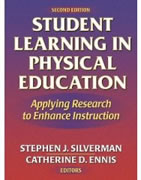|
pelinks@pelinks4u.org
Ph: 509-963-2384
Fax 509-963-1989

media
review
| 
2 MINUTE DRILLS
title: Two Bad
focus:
Coordination
equipment:
Two small beanbags per student.
directions
Extend the dominant hand (palm down). Place beanbag #1 just below
the elbow and beanbag #2 on the back of the hand. Toss the bags
upward. Catch bag #1 first with a clawing action and then bag
#2 in the same hand.
modifications:
Try on the opposite side.
|
|
|
|
| |
 |
 |
 |
|
 THIS
MONTH... THIS
MONTH...
The national AAHPERD Convention is almost here!
And for many of us the chance to escape the
winter cold couldn’t come soon enough.
For those planning to attend the Tampa convention,
be aware that the schedule is now online. If
you haven’t been there before, I’d
highly recommend downloading a copy and planning
a tentative schedule before you arrive. With
1000s of people attending and dozens of sessions
at the same time, it’s easy to be overwhelmed
and miss something interesting. pelinks4u
won’t have a booth this year in the Exhibit
Hall, but I’ll be at many of the NASPE
sponsored sessions. Here’s a link to some
of them - http://www.aahperd.org/naspe/template.cfm?template=peDayConvention.html.
Hope to see you there!
This month, in addition to a very complete
NEWS section, here are highlights of pelinks4u
contributions you can read or listen to:
Solving Obesity Part II: A Simple Plan
If it were easy to solve worldwide worsening
obesity, it wouldn’t remain a problem
today. Millions of dollars are being expended
in efforts to reverse the trend. The Robert
Woods Johnson Foundation has dedicated itself
to reversing the childhood obesity epidemic
by 2015. A myriad of national, state, and local
organizations are working at solutions. In such
a context, it is with much trepidation that
I’ve chosen to make some obesity solving
suggestions in this month’s issue. Take
a look and let me know what you think!
Future Perspectives
Frank
Forencich, is the creative mind of Exuberant
Animal - http://www.exuberantanimal.com/,
a play-based method that promotes the health,
function, and performance of individuals and
organizations. This month Frank generously shares
an essay entitled the “Shaman’s
Vision.” Frank presents an insightful,
sometimes amusing, but ultimately troublesome
perspective of the way that our society has
developed, and it’s consequences.
Preschool Healthcare
It’s going to be interesting to see what’s
contained in the about-to-be released healthcare
initiative of the newly elected federal government.
What’s certain however is that any plan
is doomed to fail unless we address ways to
effectively prevent the onset of debilitating
health conditions. This has to begin at birth
(or earlier). Michele
Silence has devoted her professional life
to developing a program that offers physical
education to preschoolers - http://www.kid-fit.com/.
This month, Michele explains how parents and
caregivers can help to develop healthy habits
early in life.
Teaching Sportsmanship and Character
One of the many benefits often claimed for physical
education is its potential to develop positive
personality traits such as sportsmanship and
good character. In fact, National Physical Education
Standard 5 directly states that a physically
educated person "Exhibits responsible personal
and social behavior that respects self and others
in physical activity settings." This month,
elementary physical education teacher and regular
pelinks4u contributing editor, Tom
Winiecki, shares practical ideas for ways
that physical educators can promote and develop
sportsmanship and teamwork in their classes.
Teaching Ideas
It's been estimated that five out of six North
Americans will be the victims of violent crime,
either completed or attempted, at least once
in their lifetime. In an article entitled, "Building
Girl's Confidence With Self-Defense" Aaron
Banks provides information and links to
download comprehensive instructional materials
that could provide the basis for a physical
education instructional unit on self-defense.
A New Approach
From the Philippines, Bienvenido
Constantino describes a new approach being
taken in physical education classes to improving
speed – a necessary quality for most sports
(and one that I’m sure explains why I
never became a professional athlete!). Bienvenido
points out that this approach is one way to
spot previously overlooked natural talent.
Adapted Physical Activity
Elyse Morin
focuses on the positive effects of physical
activity for individuals with Alzheimer’s
disease. This neurodegenerative disease typically
begins to progressively affect the brain at
around age 60. The chances of getting Alzheimer's
increases with age, and if a family member has
also had the disease. It's predicted that by
2040, about 14 million people living in the
United States will have AD or some other form
of dementia.
Thanks again for your support for improving
the quality of today’s physical education.
See you in Tampa, and look forward to a report
on the convention next month!
Steve
Jefferies, Publisher
pelinks4u |
 |
| Vote
NOW for your 2009 NASPE Board Candidates |
 Lynn
Couturier Lynn
Couturier
Dr. Lynn Couturier is currently the Chair
of the Physical Education Department at
SUNY Cortland. Her prior positions in higher
education have involved teaching, coaching,
and administration. She has also coached
interscholastic and youth sports and taught
briefly at the elementary level. Read more.
|
|
 Beverly
Mitchell Beverly
Mitchell
Beverly Mitchell is currently a professor
and the Associate Dean of Education and
Kennesaw State University in Kennesaw, GA,
a school she has taught at since 1985. Prior
to Kennesaw, she spent 14 years at Wesleyan
College in Macon, GA. Read more.
|
Listen
to each candidate, read more about all of the
Board candidates, and then VOTE
here |
 |
pelinks4u
Podcasts and Audio
To listen to podcasts located at pelinks4u
you will need iTunes software on your computer.
This is available
for free for Windows or Mac platforms. |
 |
 |
 |
SOLVING
THE OBESITY CRISIS PART II: A SIMPLE PLAN
by Steve
Jefferies, publisher, pelinks4u
In January’s
pelinks4u, I shared some
issues that seemed to me to be most important
in addressing the obesity crisis. They
were mostly observations about the challenges
we face rather than practical solutions.
So, this month, I’m sharing a perspective
on how we, as physical educators, could
take steps to address the key causes of
obesity: poor diet and insufficient physical
activity. (more...)  |
 |
SHAMAN'S
VISION: an Exuberant Animal Publication
by
Frank Forencich, Chief creative officer,
Exuberant Animal
Light was fading on the grassland as the
day drew to a close. Vibrant bands of
color streaked the sky, dancing reds and
orange illuminating the distant mountains.
The raging thunderstorms of the afternoon
were quiet now, with just an occasional
spark of lightning flashing on the horizon.
Vast herds of animals grazed in the distance
while lazy birds soared overhead. The
tribe was gathering around the fire as
it often did, eager to share stories of
the day’s adventures. The day had
been a good one, with a successful hunt
and a productive gathering of roots, nuts
and berries. A small team had gone forth
to the south and returned with a young
kudu antelope which (more...) |
 |
PRESCHOOL
HEALTH PREVENTION NOT INTERVENTION
by Michele
Silence
Diet and exercise. Calories in vs. calories
burned. The idea is to balance calories
eaten with those expended to maintain
a healthy weight and live an enjoyable
life. Experts believe this simple mathematical
equation is a first step in curbing obesity,
diabetes, heart disease and a number of
other diseases and conditions. The challenge
of course is how to set up the process
early on for children. How young can we
start? Just what should we do?
(more...)  |
 |
SPORTSMANSHIP
& CHARACTER BUILDING IN PHYSICAL EDUCATION
by Tom
Winiecki
As much as we talk about the value of
teaching sportsmanship and character in
physical education and sports, it's not
an easy task. However, a good starting
point is to ask “Where does good
character show up in a physical education
class?” And perhaps most importantly,
"What does it look like?” Based
on my experience, I suppose you could
say that it might look something like
this (more...)  |
 |
BUILDING
GIRL'S CONFIDENCE WITH SELF-DEFENSE
By Aaron
L. Banks
The incorporation of a self-defense unit
of study within secondary physical education
programs is becoming commonplace in 21st
century curricula. We are living in a
world where the threat of crime to one’s
self, belongings, or home is not only
perceived as extremely high, but very
real. It has been estimated that five
out of six North Americans will be the
victims of violent crime, either completed
or attempted, at least once in their lifetime.
(more...)  |

|
DEVELOPING
SPEED THROUGH CIRCUIT AND INTERVAL TRAINING by
Bienvenido
Constantino
Developing potential sprinters among high
school students has been a challenging
task among coaches. High school students
are growing adults and tend to be very
tardy and lazy during training. Training
in the field is not their priority due
to the influence of their peers. Their
peers are mostly found among their classmates.
Why not train the whole class if you intend
to discover potential athletes? (more...)  |
 |
WHAT
ARE THE CHARACTERISTICS OF A QUALITY
PHYSICAL EDUCATOR? - written by
Cindy
Kuhrasch; podcast by Lynn
Vandesande
Often students in our Physical Education
Teacher Preparation courses want to
hear from master teachers about their
work. However, it seems that the best
teachers are always in the classroom
perfecting their craft! Our solution?
Identify a few key questions and drop
a voice recorder off at school. The
teachers took turns considering their
answers and recording them, we created
podcasts that students could download
to their mp3 players, and our students
have benefited from years of wisdom
as a result! On this podcast, Lynn
Vandesande, a master teacher at
Muir elementary school in Madison, Wisconsin,
answers the question, "What are the
characteristics of a quality physical
educator?" Enjoy! 
|
 |
POSITIVE
IMPACTS OF EXERCISE FOR CHILDREN WITH
AUTISM by Elyse
Morin
Diagnosed
in children before the age of three,
autism is a developmental disorder that
is distinguished by its impairment of
social interface and communication,
and restrictive and repetitive patterns
of behavior, interests, and activities.
Autism now affects close to 20 out of
every 10,000 children and is diagnosed
by the presence or absence of certain
developmental behaviors. (Fact:
Experts estimate that two to six children
out of every 1,000 will have autism.
Males are four times more likely to
have autism than females. Also, more
Autism
Facts and Statistics.) (more...)  |
|
 |
|
|
|
 |
 |
 |
 |
 |
|
|
|
SITE
SPONSORS
ATHLETIC
STUFF
CTRL
WASH UNIVERSITY
EVERLAST
CLIMBING INDUSTRIES
EXERCISE
EXPRESS
GOPHER
NASCO
NEW
LIFESTYLES
PHI
EPSILON KAPPA
SPORTIME
SPEED
STACKS
S&S DISCOUNT
TOLEDO
PE SUPPLY
WINTER FEELS GOOD

|
 |
 |
| NEWS |
| PHYSICAL
EDUCATION & SPORTS |
 |
Vote
for your 2009 NASPE Candidates. Listen to the President Elect
candidates on podcast
too! |
 |
Final
2009 AAHPERD Convention
Program now available |
 |
Could
the President's
economic stimulus bill make our kids fat? Confusing language
suggests that funds might NOT be available for school gymnasium
construction. |
 |
Advocate for quality physical education by
joining NASPE for their first-ever NASPE Lobby Day event
May 6-7. Visit NASPE's website for moreinformation |
 |
The
serious need for play! Free, imaginative play is crucial
for normal social, emotional, and cognitive development. It
makes us better adjusted, smarter, and less stressed |
 |
2009
WSSA WORLD SPORT STACKING CHAMPIONSHIPS, April 18-19, Denver
Coliseum. Registration materials now available at www.worldsportstackingassociation.org
|
 |
Don't
miss SPARK's upcoming March webinar,
"SPARK Excitement In YOUR Class: How To Engage Every
Student" |
 |
The
3 R’s? A Fourth Is Crucial, Too: Recess.
Tara Parker-Hope writes that the best way to improve children’s
performance in the classroom may be to take them out of it.
|
 |
NASPE is now on FACEBOOK.
Create an account, search for NASPE under groups, and click
join. |
 |
Richard
Simmons on "Nightline" video supporting inclusion
of physical education in NCLB through the Fit
Kids Bill. |
 |
Taking
Steps Toward a 'Healthy School' - Reach out to Sport and
Recreation Organizations |
 |
The STARS project identifies and recognizes QUALITY
PHYSICAL EDUCATION PROGRAMS that provide meaningful learning
opportunities for ALL students. Check out the 2009 schools
and teachers |
 |
High
school student weighs
in on the importance of physical education in schools,
and whether or not it's time well spent for students |
 |
$30,000
NASPE grant from NASPE funds
comparison of fitness assessments with middle school attendance,
academic performance and test scores, psychological well being
and nutritional status. |
 |
2009 National Coaching Educators' Conference
June 11 - 13, 2009 at the Sheraton Station Square in Pittsburgh,
Pennsylvania |
 |
2009 NASPE Physical Education Teacher Education (PETE) conference,
October 7-10, 2009, in Myrtle Beach, South Carolina. Open
now for registrations |
 |
Interested in technology in physical education? Check out
Bonnie Mohnsen's monthly
newsletter |
 |
Annual Learning
Survey Released with Data on Kids' Playtime (Canada) |
 |
Diversification
in physical activity in precollege education is proposed
as a potential means to increase males’ enrollment in
college |
 |
Get
creative with physical education. Here are some creative
ideas, beyond team sports, regarding physical education activities
for homeschooled children. |
|
|
| PHYSICAL
ACTIVITY, NUTRITION, & OBESITY |
 |
Deskercise:
Staying Jazzed And Focused At School through Physical Activity
Breaks |
 |
Recess
before lunch policy:
Kids play and then eat |
 |
Join
more than 1,000 stackers of all ages from around the world
in beautiful Denver, Colorado for the 2009 WSSA World Sport
Stacking Championships |
 |
World
Day for Physical Activity: April 5, 2009. Focus is on
"Active Neighborhood Builds Health." |
 |
Interested
in objectively monitoring the physical activity of your students?
Here's a nice review of available
resources |
 |
The Shape Up America! Pediatric BMI
Assessment Tool calculates BMI and plots BMI percentile
on the CDC growth charts for children ages 2 to 20 |
 |
A
National Physical Activity
Plan that will help Americans become physically active
every day is being developed by researchers, healthcare professionals,
and educators throughout the United States. |
 |
QuickStats:
Mean Percentage Body Fat, by Age Group and Sex National Health
and Nutrition Examination Survey, United States, 1999--2004. |
 |
SPORT
program is an NIH intervention with multiple trials indicating
that participating adolescents significantly increase moderate
and vigorous exercise while reducing alcohol and other drug
use |
 |
Strategies
to Address Antimicrobial Resistance Act. The STAAR Act
provides important solutions to contain the spread of antimicrobial-resistant
"bad bugs" - a serious concern for sports teams.
|
 |
New
government web site to
provide important information about the recall of certain
peanut butter and peanut-containing products that are associated
with the recent Salmonella
Typhimurium outbreaks |
 |
With
child obesity a growing concern, a
bill seeks to restore physical activity at schools |
 |
Gymnastic
academy offers techie
workout |
 |
A
West Virginia law requiring schools to increase physical
education time for students and restricting access to sugary
drinks has received its first look by researchers |
 |
Obese
individuals report
higher job stress and less support from their co-workers and
bosses |
 |
Obesity
epidemic does
not appear to be correlated to an increase in cholesterol
levels for kids |
| GRANTS |
 |
FREE
use of the nation's most complete, up-to-date and easy-to-use
GRANT-FINDER for PE, Health, Special Populations and More,
compliments of S&S Discount Sports and PE at http://pe.ssww.com/grants |
 |
Grant
Opportunities Updated Monthly. Visit the NASPE Grant Opportunities
webpage for a full listing of Physical Education, Health,
Physical Activity, and related grants that you can apply for.
Login first. |
 |
Susan
G. Komen for the Cure is now accepting applications for
its 2009-2010 College Scholarship Award Program intended to
help students who would otherwise find attending college to
be a significant financial burden, due to the loss of a parent
to breast cancer. |
|
|






